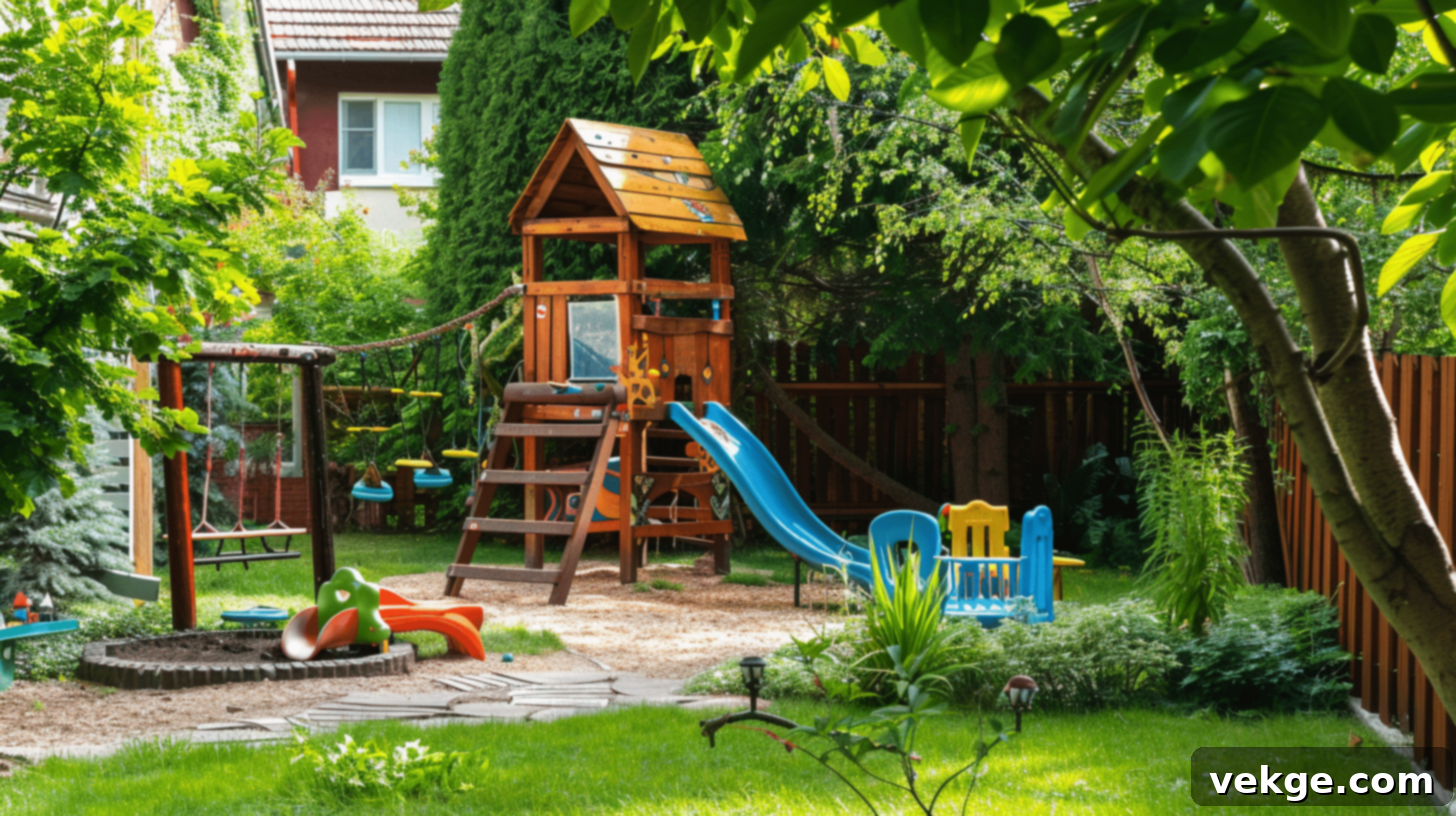Designing the Ultimate Kid-Friendly Backyard: A Comprehensive Guide to Outdoor Fun and Safety
Creating a vibrant, safe, and engaging backyard space for children is one of the most rewarding home improvement projects a family can undertake. It transforms a simple outdoor area into a dynamic hub for outdoor play, fostering creativity, encouraging physical activity, and connecting kids with nature. A thoughtfully designed kid-friendly backyard goes beyond just placing a swing set; it involves careful planning, attention to detail, and understanding the evolving needs of growing children. This comprehensive guide will walk you through essential steps and creative ideas to turn your backyard into a cherished wonderland for your little ones.
Safety First: The Foundation of a Fun Backyard
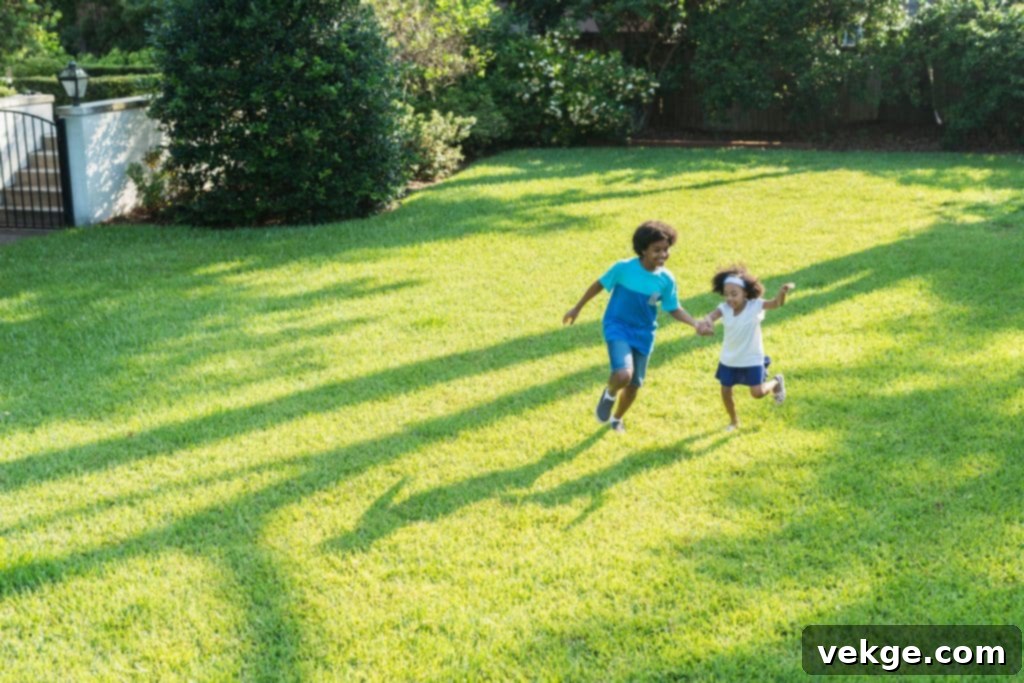
The paramount consideration when designing any space for children is safety. Before any fun elements are introduced, a thorough assessment of the area for potential hazards is crucial. Begin by inspecting your entire yard for any sharp objects, exposed nails, loose wires, or precarious structures that could pose a risk. Ensure all fences and gates are secure and in good repair, creating a protective perimeter around your play area.
Special attention should be given to plants. Research local flora and remove any poisonous plants that might be accessible to curious hands and mouths. Common examples include foxglove, lilies of the valley, oleander, and castor bean plants. If you are unsure about a plant’s toxicity, it’s best to remove it or fence it off. Similarly, make sure that any deck railings are sturdy, free from splinters, and designed with gaps narrow enough to prevent a child from getting stuck or falling through.
For homes with a swimming pool, a robust, self-latching, and self-closing pool fence is non-negotiable. Pool fences are vital in preventing unsupervised access, offering an essential layer of protection for children and pets alike. Around play equipment, consider installing soft, impact-absorbing surfaces such as rubber mulch, sand, pea gravel, or wood chips. These materials are much safer than concrete or hard-packed dirt, significantly reducing the risk and severity of injuries from falls. The depth of these materials is also important; consult manufacturer guidelines for optimal safety.
Finally, all garden tools, chemicals, fertilizers, and other potentially dangerous items must be stored securely in a locked shed or cabinet, completely out of children’s reach. Regular checks of the play area for debris, animal droppings, and potential hazards will ensure it remains a consistently safe environment for years of enjoyment.
Engaging Play Equipment for All Ages
The heart of any kid-friendly backyard is its play equipment. Carefully selected and properly installed play structures can provide countless hours of entertainment, encouraging physical development, coordination, and imaginative play. When choosing equipment, always prioritize age-appropriateness and safety standards.
For toddlers and younger children, simple swing sets with bucket seats, low slides, and sandboxes are excellent choices. Sandboxes offer a fantastic sensory experience and foster creative construction, while water tables provide refreshing fun and opportunities for scientific exploration. Ensure sandboxes have covers to keep out animals and debris. For school-aged children, classic swing sets with belt swings, taller slides, and challenging climbing frames (such as rock walls or cargo nets) will keep them engaged. A trampoline, when equipped with a safety net enclosure and supervised usage, can be a high-energy option that promotes gross motor skills and balance. Always adhere to the manufacturer’s installation guidelines and regularly inspect equipment for wear and tear, loose bolts, or rust.
If space allows, consider more elaborate structures like a treehouse or a multi-level play fort. These offer enchanting hideaways that inspire elaborate imaginative games, from secret club meetings to daring adventures. For a DIY approach, ensure any custom-built structures are robust, splinter-free, and designed with safety in mind. Remember to also budget for professional installation if you’re not confident in assembling larger play structures yourself, as proper setup is crucial for long-term safety.
Strategic Zoning for Diverse Activities
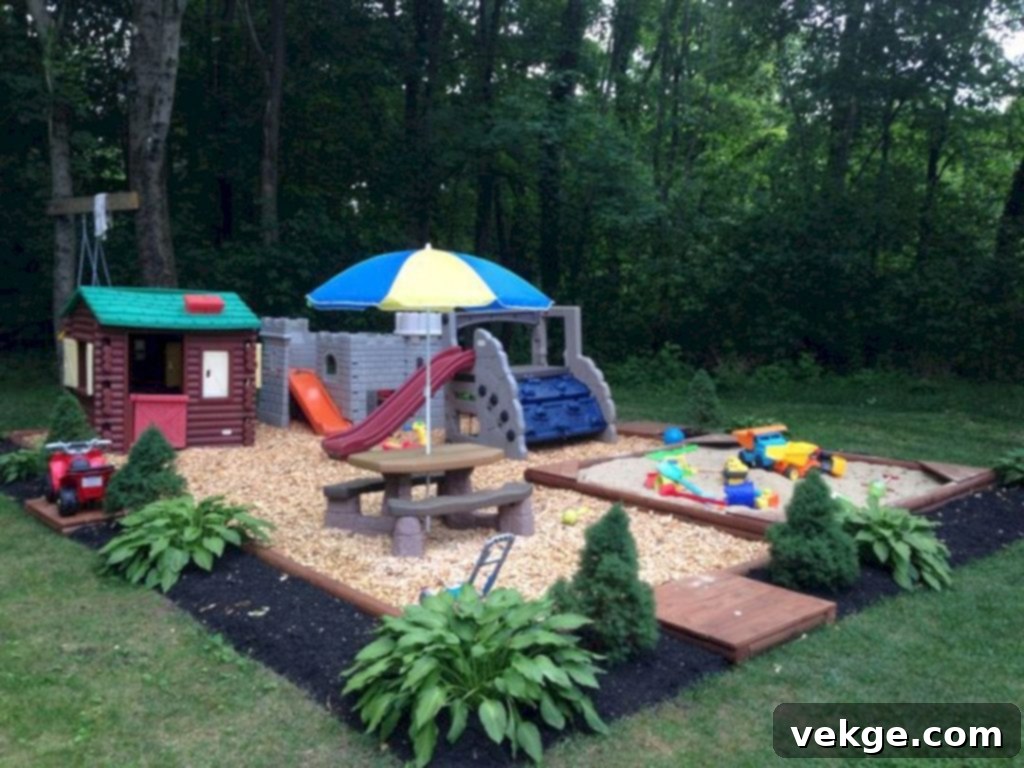
To maximize your backyard’s potential and cater to different moods and activities, consider dividing the space into distinct zones. This approach helps to organize the area, minimize conflicts, and provide a variety of experiences for children and adults alike.
A typical zoning strategy might include:
- Active Play Zone: This area is dedicated to high-energy activities. Place swings, slides, climbing frames, and open grassy areas for running, ball games, and tag here. Ensure it has the appropriate soft surfacing for safety.
- Quiet/Creative Zone: Designate a calmer spot for activities like reading, drawing, or quiet imaginative play. This could feature a small table and chairs, a cozy hammock, or even an outdoor art easel. Shaded areas are ideal for this zone.
- Nature Exploration Zone: Incorporate a small garden area where kids can engage with plants, observe insects, or simply enjoy the natural environment. This zone can also house a sensory garden, which we’ll discuss further below.
- Dining/Relaxation Zone: A space with comfortable seating, a picnic table, or a bench allows for family meals, snacks, or simply a place for parents to supervise play while relaxing.
Defining these zones can be achieved through various methods, such as low fencing, strategic planting of shrubs, different types of ground cover (e.g., grass for active play, stepping stones for pathways, mulch for garden areas), or even decorative pathways. Clear demarcation helps children understand where different activities are appropriate and keeps the backyard feeling organized and purposeful.
Igniting Curiosity with Garden Fun
Gardening is an exceptional activity that offers a wealth of educational and developmental benefits for children. It teaches responsibility, patience, introduces basic science concepts (like photosynthesis and life cycles), and fosters an appreciation for nature and healthy eating. Creating a dedicated children’s garden within your backyard provides a hands-on learning laboratory.
Start with easy-to-grow plants that yield quick results to keep children engaged. Sunflowers, cherry tomatoes, snap peas, radishes, and various herbs like mint or basil are excellent choices. These plants offer tangible rewards and make learning fun. Provide kid-sized gardening tools, gloves, and a watering can to make the activity accessible and enjoyable. Involving children in planting seeds, watering, weeding, and eventually harvesting their own produce instills a sense of pride and connection to where their food comes from.
Beyond traditional gardening, consider a “mud kitchen” for younger children, where they can mix soil, water, and natural elements to create imaginary culinary masterpieces. This encourages sensory play and creativity. You can also introduce basic composting concepts, teaching them about decomposition and recycling organic waste, further deepening their understanding of natural cycles.
Interactive Elements to Spark Imagination
Beyond standard play equipment, integrating interactive elements can significantly boost creativity and sensory engagement in your backyard. These features encourage active participation and provide diverse ways for children to express themselves.
- Chalkboard Walls or Easels: An outdoor chalkboard wall, made from a piece of plywood painted with chalkboard paint, provides an expansive canvas for drawing, writing, and imaginative games. Easels offer a more traditional art experience. These elements encourage artistic expression and can be easily wiped clean for new creations daily.
- Water Features: Simple water elements can be incredibly captivating. A small splash pad, a series of outdoor water tables, or even a child-safe mini-fountain can offer refreshing sensory play. Always ensure any water features are designed with safety in mind, especially for younger children, and supervise play closely.
- Music Makers: Incorporate elements that produce sound. Outdoor xylophones, chimes, or even repurposed pots and pans as drums can create a dedicated music zone. This encourages auditory exploration and rhythm development.
- Building Stations: A designated area with large, weather-resistant building blocks, natural materials like large sticks, stones, or tree stumps can encourage constructive play and problem-solving skills.
- Storytelling Corners: A cozy nook with a small stage or just some comfortable seating can inspire children to create and perform stories, enhancing their language and dramatic play skills.
These interactive elements don’t just fill space; they create dynamic opportunities for children to learn, grow, and entertain themselves in varied ways.
Comfortable Seating for Relaxation and Supervision
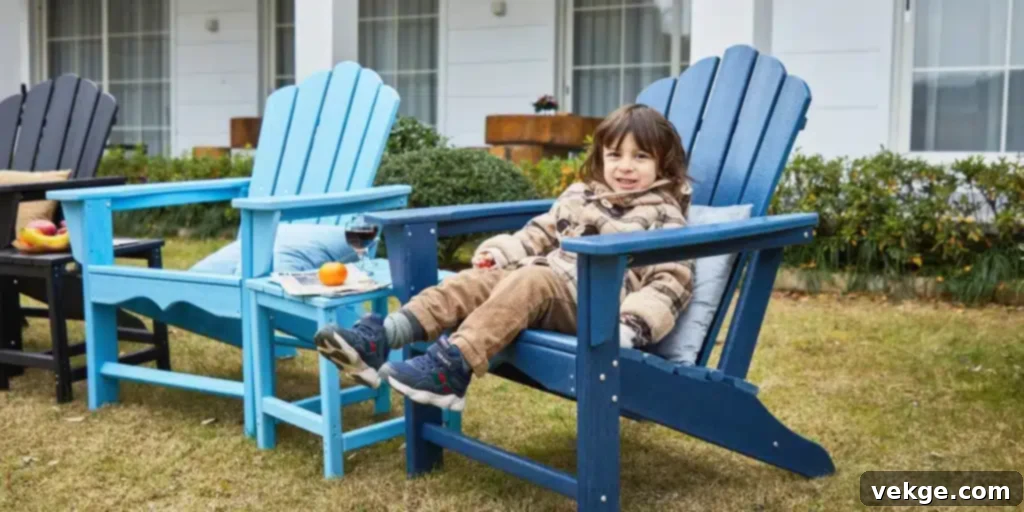
A truly kid-friendly backyard also caters to the comfort of both children and supervising adults. Providing ample, comfortable seating allows for moments of rest, reading, snacking, or simply observing the joyous chaos of play. Consider a variety of seating options to suit different needs and areas of the yard.
Benches, picnic tables (perhaps a child-sized one), Adirondack chairs, or even a soft hammock can offer inviting spots for relaxation. Place seating strategically: near active play areas for easy supervision, or in a quieter corner for a peaceful retreat. When choosing outdoor furniture, opt for durable, weather-resistant materials that are easy to clean and maintain. Adding colorful outdoor cushions or bean bags can further enhance comfort and inject personality into the space.
Equally important is providing adequate shade. On sunny days, protection from harmful UV rays is essential. Install umbrellas, retractable canopies, pergolas with climbing vines, or shade sails to create cool, comfortable zones. Natural shade from mature trees is also ideal. Ensuring children have access to shaded areas helps prevent sunburn and overheating, allowing for longer, safer outdoor play sessions.
Dedicated Space for Sports and Games
Physical activity is paramount for children’s health and development, and a backyard can be an excellent venue for fostering a love of sports and games. Designate a flexible open space that can accommodate various activities.
A small, well-maintained grassy area is perfect for impromptu soccer games, practicing catching and throwing, or a lively game of tag. Depending on your space and budget, you could install a permanent basketball hoop, a removable badminton net, a tetherball pole, or even a simple cornhole game set. For younger children, a hopscotch grid painted on a paved surface or a small, soft T-ball set can be great additions. Having a variety of options encourages different types of movement, builds diverse motor skills, and keeps kids engaged by offering choices.
Don’t forget about storage for sports equipment. Designated bins or a small shed will help keep balls, rackets, and other gear organized and easily accessible, encouraging children to put things away after play. Teaching children fair play, teamwork, and good sportsmanship through backyard games is an added bonus.
Engaging the Senses with a Sensory Garden
A sensory garden is a fantastic addition to a kid-friendly backyard, designed to stimulate all five senses through carefully chosen plants and elements. This type of garden can be particularly beneficial for children with special needs, but it offers a rich and engaging experience for all kids.
- Touch: Include plants with varying textures like the soft, fuzzy leaves of Lamb’s Ear (Stachys byzantina), the spiky foliage of certain ornamental grasses (ensure they are not too sharp), or the smooth bark of certain trees. Textured stepping stones or a winding path made of different materials can also engage the feet.
- Smell: Plant fragrant herbs like lavender, mint, rosemary, or lemon balm. Scented geraniums, jasmine, or sweet peas can also add delightful aromas to the air.
- Sight: Incorporate plants with vibrant colors, interesting shapes, and varied heights. Think bright sunflowers, colorful zinnias, or plants with variegated leaves. Bird feeders will attract colorful birds, adding dynamic visual interest.
- Sound: Choose plants whose leaves rustle in the wind, like bamboo or ornamental grasses. Add wind chimes, a gentle water feature, or even encourage local wildlife like birds and beneficial insects to bring natural sounds to the garden.
- Taste: With strict supervision, include edible plants like cherry tomatoes, strawberries, blueberries, or accessible herbs. This allows children to experience the taste of fresh produce directly from the garden.
A sensory garden is not just about plants; it’s about creating an immersive experience that encourages exploration, discovery, and a deeper connection to the natural world. It can be a calming retreat or an exciting adventure for young minds.
Involve the Kids in the Design Process
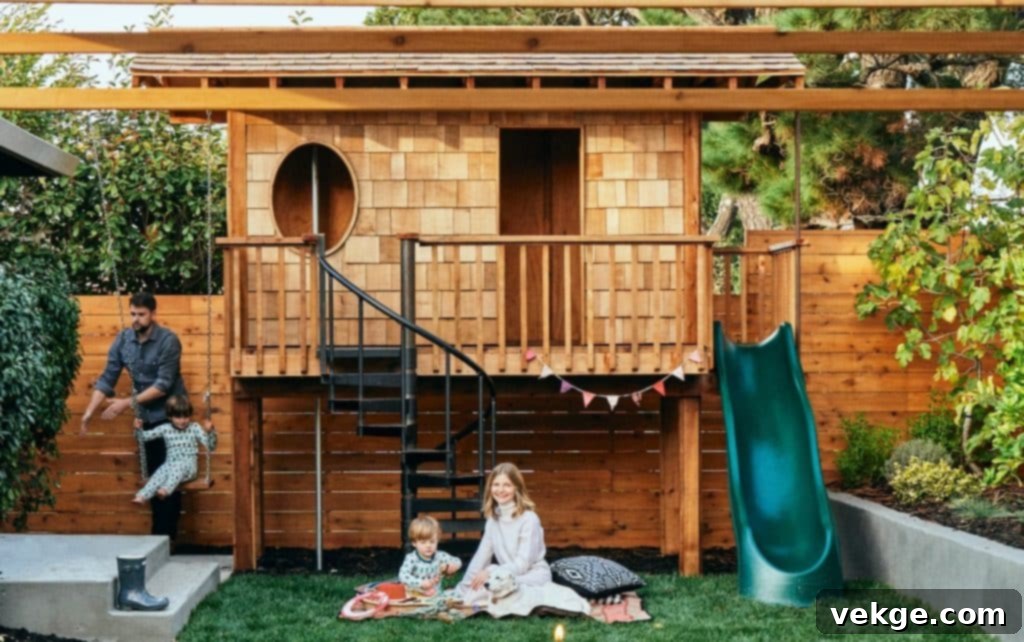
One of the most effective ways to ensure your backyard truly resonates with your children is to involve them directly in the planning and creation process. This collaborative approach not only makes the space more appealing to them but also instills a powerful sense of ownership, pride, and responsibility.
Start by asking them what activities they enjoy most outdoors. Do they love climbing? Digging? Painting? Reading? Let them brainstorm ideas and draw their dream backyard. You might be surprised by their imaginative suggestions. Involve them in practical decisions too, such as choosing colors for outdoor furniture, selecting plants for their garden patch, or deciding where a particular play element should go. For older children, they can assist with simple tasks like watering plants, raking leaves, or helping to paint a fence.
When children feel that their ideas and efforts have contributed to the creation of the space, they are far more likely to engage with it, care for it, and cherish it. This involvement fosters decision-making skills, teamwork, and a deeper connection to their outdoor environment, transforming the backyard from just a space into ‘their’ special place.
Conclusion: A Backyard Designed for Lasting Memories
Transforming your backyard into a kid-friendly haven is an investment in your children’s development, happiness, and overall well-being. It requires a thoughtful balance of prioritizing safety, integrating diverse play opportunities, and designing spaces that cater to different activities and moods. From robust safety measures and engaging play equipment to educational garden zones and interactive elements, every detail contributes to a rich outdoor experience.
By focusing on essential aspects such as ensuring a secure environment, providing a variety of age-appropriate play structures, and strategically zoning areas for different types of activities, you can craft a dynamic outdoor living space. Including your children in the planning and creation process not only ensures the space aligns with their preferences but also fosters a sense of ownership and pride. Ultimately, a well-designed kid-friendly backyard becomes more than just a play area; it evolves into a beloved family destination where imagination flourishes, skills are honed, and countless cherished memories are made for years to come.
